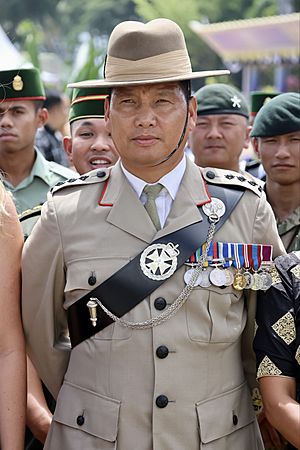Captain (British Army and Royal Marines) facts for kids
Quick facts for kids Captain |
|
|---|---|
 
Army and Royal Marines insignia
|
|
| Country | |
| Service branch | |
| Abbreviation | Capt |
| NATO rank | OF-2 |
| Non-NATO rank | O-2 |
| Formation | c. 1815 |
| Next higher rank | Major |
| Next lower rank | Lieutenant |
| Equivalent ranks |
|
A Captain (often shortened to Capt) is an important rank for a junior officer in the British Army and Royal Marines. This rank is above a lieutenant and below a major. It has a special code, OF-2, which helps compare ranks across different countries in NATO.
The rank of Captain is similar to a lieutenant in the Royal Navy and a flight lieutenant in the Royal Air Force. It's important not to confuse an Army or Royal Marines Captain with a Captain in the Royal Navy. A Royal Navy Captain is a much higher rank, similar to an Army Colonel.
Today, in the British Army, captains often act as the second-in-command (2IC) of a company. A company is a military unit that can have up to 120 soldiers. The captain helps lead and manage these soldiers.
History of the Captain Rank
The rank of Captain has a long history in the British military. Around the time of the Battle of Waterloo (in 1815), there was a rank called "second captain" in the Ordnance, which dealt with military supplies.
For a short time, from 1918 to 1919, the Royal Air Force (RAF) also had the rank of Captain. RAF captains wore insignia that looked like two bands, similar to a naval lieutenant, with an eagle and crown above them. This rank was later changed to flight lieutenant.
Understanding Rank Insignia
Rank insignia are the special badges or symbols that show an officer's rank. For captains, these badges were first introduced on January 30, 1855. They were worn on the shoulder epaulettes, which are decorative shoulder pieces.
After the Crimean War, a new system for rank insignia was created. This was the first time the British Army had a complete set of badges for all ranks. A captain's insignia was worn on the collar and included a crown and a pip. A pip is a small star-like symbol.
In 1880, the rank insignia for officers in their full dress uniforms were moved back to the shoulder boards. The system of crowns and stars was also changed. From then until 1902, a captain had two stars. In 1902, captains started wearing three stars, which is still used today.
Besides shoulder badges, officers' ranks were also shown by the amount of gold lace on the cuffs of their full-dress tunics. During World War I, some officers started wearing their rank badges on their shoulders instead of their cuffs. This was because cuff badges made them easy targets for enemy snipers. This practice became official in 1917 and was made permanent in 1920, when cuff badges were removed.
See also
- British and U.S. military ranks compared
- British Army Other Ranks rank insignia
- British Army officer rank insignia




